
Trachymene is a genus of herbaceous plants in the family Araliaceae. The species are native to Australia, Malesia, New Caledonia and Fiji.

Schenkia australis is a species of annual herb in the Gentianaceae family. It is endemic to Australia.

Erodium cygnorum is a species of herb native to Australia.
Senecio glossanthus is an annual herb native to Australia. In Western Australia it is commonly known as slender groundsel.

Eremaea pauciflora is a plant in the myrtle family, Myrtaceae and is endemic to the south-west of Western Australia. It is a shrub with small leaves and orange flowers at the ends of its branches. It has the most widespread distribution of the eremaeas with considerable variation in its characteristics so that three varieties are recognised. It was the first Eremaea to be described formally but was not originally given the name Eremaea.

Persoonia glaucescens, commonly known as the Mittagong geebung, is a species of flowering plant in the family Proteaceae and is endemic to New South Wales. It is an erect shrub with smooth bark, hairy young branchlets, lance-shaped leaves with the narrower end towards the base, and yellow flowers. It is the only persoonia in eastern Australia with strongly glaucous leaves.
Dasymalla axillaris, commonly known as native foxglove or woolly foxglove, is a flowering plant in the mint family Lamiaceae and is endemic to Western Australia. It is a small, diffuse shrub with its branches, leaves and some of its flower parts densely covered with white, woolly hairs. The flowers are a shade of red and tube-shaped with the stamens and style extending beyond the end of the five petals.

Cuscuta australis, commonly known as Australian dodder, is a herb in the family Convolvulaceae.
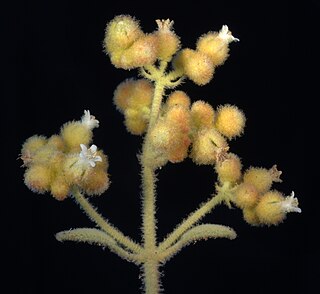
Dicrastylis exsuccosa is a species of plant within the genus, Dicrastylis, in the family Lamiaceae. It is endemic to inland Australia and found in Western Australia, the Northern Territory and South Australia.

Lawrencia squamata is a species of plant in the mallow family, Malvaceae. It is endemic to Australia and occurs in all Australian states.

Scaevola canescens is a species of plant in the family Goodeniaceae. It is endemic to Western Australia where it occurs "from Shark Bay to Perth, in open forest and heath in sandy soil".
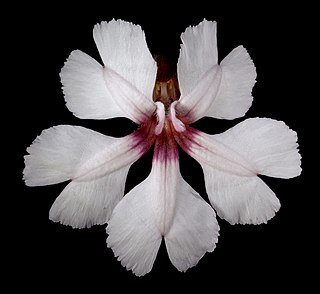
Velleia rosea is a species in the family Goodeniaceae that is native to Western Australia and flowers from April to October.
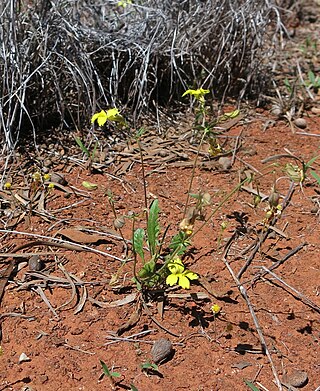
Velleia glabrata is an annual herb in the family Goodeniaceae, which is native to all mainland states and territories of Australia with the exception of Victoria. It grows on sand and clay, flowering from June to October.

Calandrinia corrigioloides is an annual herb in the family Montiaceae, and is native to Western Australia, South Australia, and Victoria.

Tephrosia glomeruliflora, or pink tephrosia, is a perennial (non-climbing) herb in the family Fabaceae, endemic to South Africa. It is also found on the eastern coast of Australia, in New South Wales and Queensland, where it is considered an environmental weed.

Xanthosia atkinsoniana, is a small herb in the family Apiaceae. It grows in both New South Wales and Western Australia.

Pimelea curviflora, also known as curved rice-flower, is a shrub in the family Thymelaeaceae and is endemic to Australia. It is a small, hairy shrub with greenish-yellow or red tubular flowers.
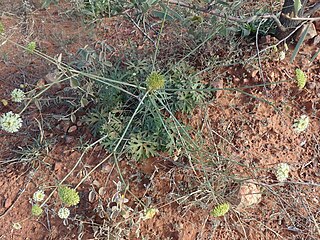
Trachymene ochracea is a herb in the family Araliaceae. It is native to Australia and found in New South Wales and Queensland.
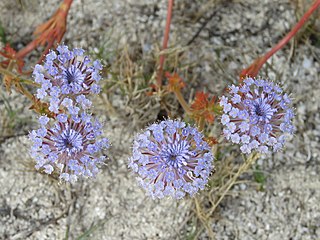
Trachymene coerulea is a herb in the family Araliaceae. It is native to Western Australia.
Cratystylis conocephala, the blue bush daisy, blue bush, grey bush, and round leaved greybush, is a species of flowering plant in the family Asteraceae, native to southeast Western Australia, South Australia, New South Wales, and Victoria. It is a densely branched, spreading shrub. The species is listed as endangered in New South Wales and critically endangered in Victoria.




















